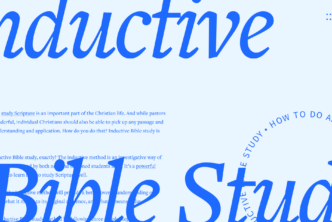Many people start their Bible study in the Gospels. Over time, the word “gospel” has come to mean several things, such as the good news that Jesus has victory over sin and death, but in this case “Gospel” means a particular type of literature.
Matthew, Mark, Luke, and John are Gospels; they are a particular kind of narrative about the life of Jesus, a story that includes both some brief examples of his teaching and some key events in his life. About a hundred years after Jesus lived, a philosopher named Justin called the four books memoirs. This is because they tell the story of Jesus’ life, with some features of modern biographies.
Beginning in the Gospels
So to study the life of Jesus, there are four options, all authoritative but slightly di! erent. Before diving in, a few basic suggestions: Most print Bibles have little numbers that distinguish chapter and verse, and many have the words of Jesus in red-colored type. These enhancements are modern inventions; they were created with good intentions but probably hinder, more than help, the beginner’s study of the Gospels. Because the Gospels are stories, they are meant to be read more like novels than a list of suggestions or a blog post.
So get a copy of the New Testament that is as distraction-free as possible (fewest notes, numbers, and colors) in one or two readable translations (such as the New Living Translation), find a quiet spot with a comfortable chair, and pick one of the four Gospels.
First-century movies
Start with whichever Gospel most appeals to you. There is no correct order. Matthew takes the most time getting to the teachings of Jesus. Mark is short and to the point. Luke contains the most detail. You’ll notice upon later readings that Matthew, Mark, and Luke have many similar stories (though each has unique stories as well). The fourth Gospel, John, is quite different from the rest; it is the one most like ancient dramas.
Another challenge you will encounter is that you will find it hard to “get into” any the four Gospels. It’s not you, and it’s not them—it’s simply the fact that your culture and their culture are very different. Likewise, I have always struggled to watch any movie made before 1980. Movies from the 1950s and 1960s seem really boring to me—the pacing and plot just drag. Movies from the 1910s? Forget about it.
When you go to read the Gospels, you may feel the same way. The pacing feels off, and it is, because it was written for a totally different, first-century audience. What makes it so much worse is when we try to read the Gospels a verse or two at a time, especially out of order. It ruins the flow completely.
I suggest reading these books from start to finish. I also find that capturing the drama of a Gospel works best when we listen to it read aloud to us.
The two main sections of each Gospel
When you read the Gospels, there are two main sections to each story: (1) the teachings of Jesus and (2) the key events—especially Jesus’ death, burial, and resurrection. When you read the teachings of Jesus, you’ll encounter many little stories called parables—they are not designed to give you answers; they are designed to make you think. Pause briefly after reading each one, and think through their meaning. The key events are short, and they tend to speak for themselves.
Study resources
Once you’ve read each Gospel a couple of times, you will want to pick up some Bible study resources. The first step is to add a few more translations to your diet—maybe something more word-for-word like the New American Standard Bible or something more poetic, like The Message.
The next step is to add resources that can help answer your questions when they arise. Definitely resist the temptation to Google for answers! Your best bet is to find published resources rather than merely random things online. The many tools available on Logos make that a great starting place; for example, one resource that I helped create was the Lexham Context Commentary. Also, as you study, reach out to a few good Christian friends from church to dialogue with about what you’re learning.
Last, but also first, pray that God will enhance your understanding of who Jesus is and what he did for you.
***
This article was originally published in the September/October 2021 issue of Bible Study Magazine. Slight adjustments, such as title and subheadings, may be the addition of an editor.
Related articles
- How to Do In-Depth Study of God’s Word (3 Steps)
- 29 Bible Study Tools for Reading the Bible More Effectively
- The Meaning of Baptism—and How It Makes the Gospel Visible
Related resources
Mobile Ed: NT311 The World of Jesus and the Gospels (3 hour course)
Regular price: $109.99





